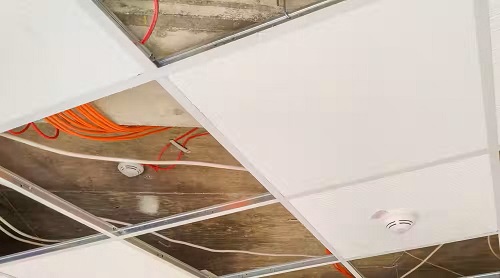
3.15.22 -EC&M – Mark Lamendola
Plan equipment layout, then plan the cabling
Suspended ceilings in commercial buildings have grown in purpose and importance over the past few decades. At one time, they provided a grid for installing fluorescent troffers and created an overhead space for the wiring. Aside from PA system cabling and some fire alarm system wiring, very little else ran in this space.
But then low-voltage devices started proliferating, mostly in the form of building control and security. To prevent a hodgepodge of power supplies and a bird’s nest of wiring, manufacturers started building low-voltage power distribution systems and installers started using them. And today, even the lighting is going the low-voltage route due to LED lighting technology.
And it isn’t just in commercial buildings where you find these systems. They show up in industrial and residential buildings, too.
The NEC permits a low-voltage power distribution system if it consists of four major components [393.6(B)]:
- Listed low-voltage utilization equipment.
- Listed Class 2 power supply.
- Listed or identified fittings, connectors, and/or grid rails.
- Listed low-voltage cables per 725.179 or other fixed wiring methods for the secondary circuit.
Of course, those Class 2 power supplies get supplied by branch circuits. In a well-laid-out system, the branch circuit wiring and the secondary wiring are kept separated. The key to getting a good layout is to plan locations for each type of utilization equipment that might be used and plan the cabling as if those devices were actually being installed.
It’s not necessary to install the cabling to each phantom device; the point is to allow room for it when routing the cabling you need to run. It is not a good practice to install what you have and wire it point-to-point as if nothing else will ever be added.
You can install these power distribution systems indoors in dry locations [393.10(2)], but you can’t install them in damp or wet locations [393.12(1)]. You can install them in suspended ceiling spaces and in environmental air spaces [393.10(4)], but you can’t install them in concealed locations [393.12(4)]. You can’t install them in hazardous locations Wi-Fi [393.12(5)] or use them for lighting in patient care areas (general or critical [393.12(7)].
A disconnect is required on the load side of the Class 2 power supply to permit servicing or maintaining the grid [393.21(A)]. It has to be accessible and within sight of the Class 2 power supply.
A couple of the NEC requirements are common sense ones applying to all installations:
- Must be installed in a neat and workmanlike manner [393.14(A)].
- Must not be subject to physical damage [393.12(3)].
Take care when bonding. With these systems, you bond the supply side of the Class 2 power supply to the equipment grounding conductor [393.60(A)]. However, you do not bond the load side of the Class 2 power supply to the equipment grounding conductor [393.60(B)].
